

Design Thinking for Campus Mental Health - andrealyip.
Www.ideo.com/images/uploads/thoughts/IDEO_HBR_Design_Thinking.pdf. Open IDEO. Doing Good Work - the Ron Berger Interview. Customer Journey. Pedagogical Patterns. A design thinker’s cheat sheet. As an entrepreneur, I have been designing products, services and solutions for most of my professional life.
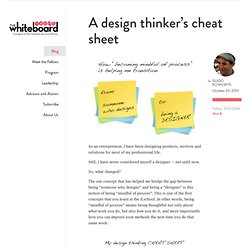
Still, I have never considered myself a designer — not until now. So, what changed? The one concept that has helped me bridge the gap between being “someone who designs” and being a “designer” is this notion of being “mindful of process”. This is one of the first concepts that you learn at the d.school. In other words, being “mindful of process” means being thoughtful not only about what work you do, but also how you do it, and more importantly how you can improve your methods the next time you do that same work. d.school Fellow Guido Kovalskys presents his design thinking “cheat sheet”. So, the long and the short of it is, you too can become a designer. . #1 – Pick one among the challenges you face daily. . #2 – Develop an awareness for the process you follow to tackle that challenge. . #3 – Now comes the hardest part. Done! Now, becoming a good designer is a whole other ball game. Design Thinking: A Full 90-Minute Challenge For Schools. Design thinking is a process harnessed in the creative industries, particularly in product and service design.
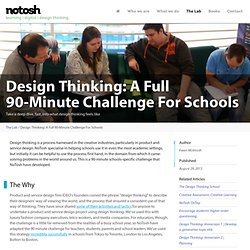
NoTosh specialise in helping schools use it in even the most academic settings, but initially it can be helpful to use the process, first hand, in the domain from which it came: solving problems in the world around us. This is a 90-minute schools-specific challenge that NoTosh have developed. Pitch your ideas to make them happen. NoTosh was born from working alongside tech startups, helping them find the kernel of their big ideas and then pitch those ideas effectively to potential investors.

The creation of a strong pitch itself helps change the idea - for the better - and bring more people to help make your idea become reality. Design Thinking: A Full 90-Minute Challenge For Schools. Design Thinking. Hacking the Classroom: Beyond Design Thinking. Design Thinking is trending is some educational circles.
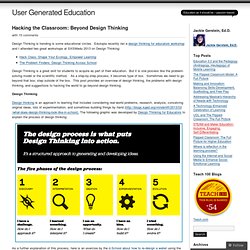
Want A Crash Course In Stanford’s Design Thinking? Here it is for free (Pt. 1 Empathy) The Institute of Design (D.School) at Stanford has become one of the most talked about institutions recently because of the methodology they are spreading around the world to improve our lives through a collaborative approach that inspires human centered innovations.
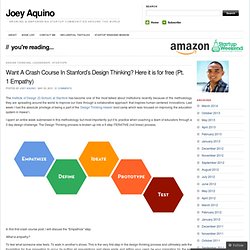
Last week I had the absolute privilege of being a part of the Design Thinking Hawaii boot camp which was focused on improving the education system in Hawai’i. I spent an entire week submersed in this methodology but most importantly put it to practice when coaching a team of educators through a 3 day design challenge. The Design Thinking process is broken up into a 5 step ITERATIVE (not linear) process. Design Thinking for Educators. Use our methods. Week Four: Experimentation and Evolution. After our fabulous brainstorms, now it's time to select and create a prototype You’ve come to many new ideas for library, and the next step is to start to choose some of those ideas and make them real.
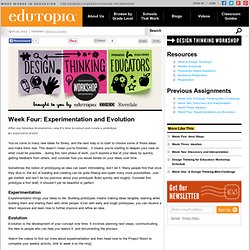
This doesn’t mean you’re finished... it means you’re starting to deepen your view on what could be possible... during this next phase of work, you’ll explore a few of your ideas by quickly, getting feedback from others, and consider how you would iterate on your ideas over time. Sometimes the notion of prototyping an idea can seem intimidating, don’t let it. Many people find that once they dive in, the act of building and creating can be quite freeing and spark many more possibilities. World Café Etiquette Graphics. This World Café Cafe Etiquette graphic was created by reflective visual graphics professional Avril Orloff for you to print out as a poster for your World Café event... there are three sizes to choose from, depending on your needs.
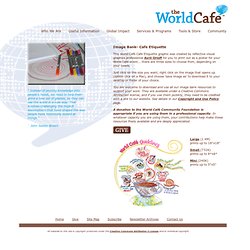
Just click on the size you want, right click on the image that opens up (option click on a Mac), and choose 'save image as' to download it to your desktop or folder of your choice. You are welcome to download and use all our image bank resources to support your work. They are available under a Creative Commons Attribution license, and if you use them publicly, they need to be credited with a link to our website. Pinterest. Pinterest. d1lhirsz7m8sbi.cloudfront.net/mindshift/wp-content/blogs.dir/42/files/2013/10/iLab_infographic_11x171.pdf.
Design Process Mini-Guide. The Design Process Mini-Guide is five-page document outlining a design process we teach here at the d.school.
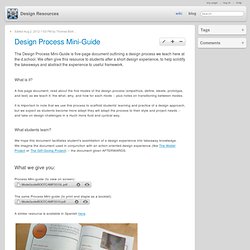
We often give this resource to students after a short design experience, to help solidify the takeaways and abstract the experience to useful framework. What is it? A five-page document; read about the five modes of the design process (empathize, define, ideate, prototype, and test) as we teach it: the what, why, and how for each mode -- plus notes on transitioning between modes. Basic rubric 1 point 0.pdf?sessionID=2f943b9faf52995747c16e1a5252bcfb6cc2f9a5. Our point of view. Students come to the d.school with an intense curiosity, a deep affinity for other people, and the desire to gain an understanding beyond their own experience.
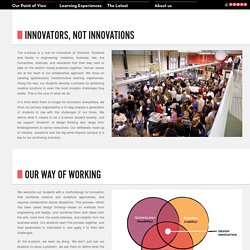
They come from every school on campus, and beyond. Instead of working on different pieces of the same project, they navigate each step in the innovation process together, leveraging their differences as a kind of creative engine. The design thinking process becomes a glue that holds teams together, allowing students to unleash intuitive leaps, lateral thinking, and new ways of looking at old problems. Our teaching teams, too, combine contrasting view points and problem-solving approaches. All of our classes are team taught by a robust mix of faculty and industry leaders, combining disciplines like computer science with political science, and CEOs with elementary school policy-makers. HFLI Rubric. Welcome to the page hosting assessment prototypes created by the Henry Ford Learning Institute (HFLI).
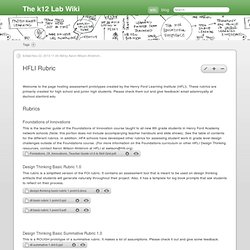
These rubrics are primarily created for high school and junior high students. Please check them out and give feedback! Guide v2.0 %26 Skill Grid.pdf?sessionID=2f943b9faf52995747c16e1a5252bcfb6cc2f9a5. Chart a New Course: Put Design Thinking to Work. If you just ran the d.gift crash course, we hope you and your team found it to be a valuable experience, and you’re excited about doing more design thinking. If so, you are likely asking yourself how to maintain the momentum and integrate a design approach into your work. Well, guess what? (Three actually. We stayed up all night!) Creative Confidence by Tom & David Kelley. Mindsets, methods, case studies and more — Design Kit is IDEO.org‘s platform to learn human-centered design, a creative approach to solving the world’s most difficult problems. A directory of schools and programs that use design thinking in the curriculum for K12 students — a resource created by IDEO and the K12 Lab Network at Stanford’s d.school.
In this segment of 60 Minutes, Charlie Rose visits IDEO and interviews co-founder David Kelley. Rose also discusses the future of design thinking, delves deeper into human-centered design with David in his home, and learns about creative confidence. More footage from 60 Minutes’ time at IDEO here. Creative Confidence by Tom & David Kelley. Creative Confidence by Tom & David Kelley. Sites/dmlcentral/files/resource_files/Quest_to_LearnMacfoundReport.pdf. Beyond teacher egocentrism: design thinking. As teachers we understandably believe that it is the ‘teaching’ that causes learning. But this is too egocentric a formulation. As I said in my previous post, the learner’s attempts to learn causes all learning. The teaching is a stimulus; the attempted learning (or lack of it) is the response. No matter what the teacher says or does, the learner has to engage with and process the ‘teaching’ if learning is to happen.
From this viewpoint, the teacher is merely one resource for learning, no different from a book, a peer, an experience, or an experimental result. Open Webinar on Design Thinking (with tweets) · kristenswanson. How might we assess design thinking prowess? HFLI Rubric. Welcome to the page hosting assessment prototypes created by the Henry Ford Learning Institute (HFLI). Videos, Common Core Resources And Lesson Plans For Teachers: Teaching Channel. How To Design Rubrics To Assess Learning.
Will Richardson on knowmadic schooling.